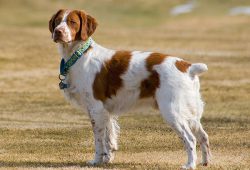The Brittany is a breed of gun dog bred primarily for bird hunting. Although it is often referred to as a Spaniel, the breed’s working characteristics are more akin to those of a pointer or setter. Brittanys were developed in the [wiki base=”EN”]Brittany[/wiki] province of [wiki base=”EN”]France[/wiki] between the 17th and 19th centuries, becoming officially recognized early in the 20th.
Description
Appearance
The Brittany is typically quite athletic, compact, energetic, and solidly built without being heavy. Their heads are of average size with floppy ears, expressions usually of intelligence, vigour, and alertness, and gait elastic, long, and free.
Most Brittanys are born with naturally short tails, yet others are rarely born with long tails, which are docked to a length of 3–10 centimetres (1.2–3.9 in)
The breed’s coat color is varied: orange and white coat or liver and white are most common in the American Brittany; other colors include orange roan and liver roan, all of which are acceptable in the show ring. The American Brittany Standard specifies an acceptable tri-color of liver, orange, and white with very specific color placement.
Size
Brittanys are medium-sized dogs, with American lines (17.5–20.5 inches (44–52 cm) at the withers according to an AKC standard adopted in 1990) tending to be larger and have a blockier head than French (17–20.5 inches (43–52 cm)), and females at the lower end. A properly constructed and healthy Brittany maintains a weight between 30–45 pounds (14–20 kg), depending upon height.
Temperament
The Brittany was originally bred as a hunting dog and noted for being easy to train and sweet-natured. The breed is generally more sensitive to correction than other hunters, and harsh corrections are often unnecessary. Brittanys can become very shy if not thoroughly socialized at a young age, and even among well-socialized dogs there is significant variation in levels of friendliness.
When well socialized, Brittanys are all around sound dogs, excelling as companions, family pets, field dogs. Eager to please and friendly, they generally learn quickly and are loyal and attached to their owners. They are energetic and need at least an hour of vigorous exercise every day, with many needing more than this. Some animals will be over-active or hyper-sensitive, but these problems are almost invariably due to lack of exercise and training, and are not characteristics of well cared-for dogs.
Health
Brittanys are generally healthy and hardy dogs. The median lifespan for Brittanys in France is 12.6 years. A UK Kennel Club survey puts the breed’s median lifespan at 12 years 11 months, with about 1 in 5 dogs dying of old age at an average of 14–15 years. Brittanys have no undercoat and need minimal grooming or bathing. However, their floppy ears tend to trap moisture in the ear canal and should be cleaned regularly.
Diseases found in the breed include [wiki title=”Hip_dysplasia_(canine)” base=”EN”]Hip dysplasia[/wiki], with 14.9% of Brittanys tested between 1974 and 2009 by the Orthopedic Foundation for Animals displaying the condition, and a lesser rate of 10.3% for dogs born 2003-2004. The breed is listed among those commonly affected by [wiki title=”Canine_discoid_lupus_erythematosus” base=”EN”]Canine discoid lupus erythematosus[/wiki]. [wiki title=”Epilepsy_in_animals” base=”EN”]Epilepsy[/wiki] is also found.
Brittany (breed). (2017, July 26). In Wikipedia, The Free Encyclopedia. Retrieved from https://en.wikipedia.org/w/index.php?title=Brittany_(breed)&oldid=792386400


